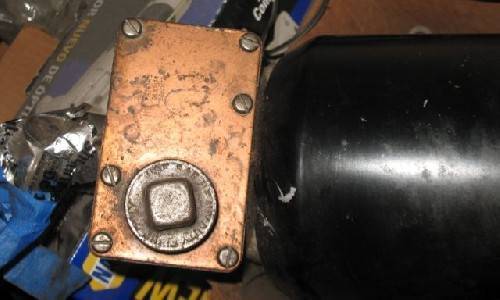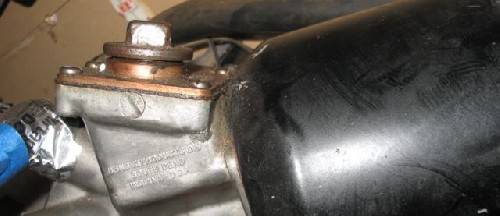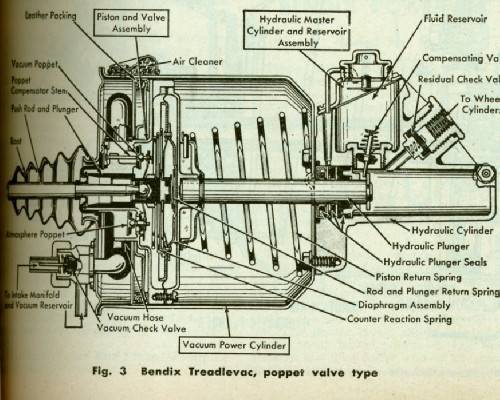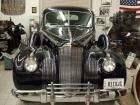|
Re: Easamatic Rebuild Sources
|
||||
|---|---|---|---|---|
|
Home away from home

|
Quote:
I hear what you're saying here, but it does not quite square (in my mind) with what I observed after looking at the gasket. It looked to me (check pic closely on this) that the gasket had bellied into the relief port hole enough to plug the hole. Almost as though there and been some actual vacuum applied to it. The gasket definitely does extend OVER the place where the hole is, so any fluid getting past would have to sneak under the gasket. If that is the way it's supposed to work it's pretty weird. But I can see where if you notched the gasket to completely clear the port, there wouldn't be much gasket material between the port and the edge of the reservoir, creating the possibility of exterior leaks. So, if you can, 'splain to me one more time how the pictured gasket could have left any space for fluid to re-enter the reservoir. Also, does it act as just a one-way relief port, or does it also vent somehow in the opposite direction? I would think a flat cover would complicate things even more, but I understand by the pictures HH56 showed of the reservoir that the relief port was somehow repositioned on these to allow venting. ABOUT THE CLEAN SPOT IN THE RESERVIOR: This was created not by fluid washing it as it returned from the port, but from repeated addition of fluid after the reservoir went dry. I also squirted carb cleaner in there once to try to get the compensator valve flushed out-- with some success it appears. The valve looks pretty clean and positioned right, by what I've seen.
Posted on: 2013/8/13 14:52
|
|||
|
Guy
[b]Not an Expert[/ |
||||
|
||||
|
Re: Easamatic Rebuild Sources
|
||||
|---|---|---|---|---|
|
Home away from home

|
Quote:
"Academic" or not, your observation raises some interesting possibilities. Might this lack of fluid be one reason that the vacuum seals fail? Any hydraulic seal I've ever heard of has to be used regularly in the presence of fluid in order to stay pliable. Could this also be a reason for the "plunger" (or "hydraulic cylinder piston" as the manual calls it) to become pitted? "Lube" would also be absent on the piston, leaving it in a dry condition. But how good of a "lube" is brake fluid? I've always heard that it's glorified anti-freeze. This is a good discussion, I think, because the variations of brake fluid we have today that weren't available in the old days may be just the ticket to keep these parts in shape. I am now using "Dot 3" which isn't exactly the latest thing. But I believe it's compatible with other fluids, so a changeover wouldn't be out of the question. Maybe one of the newer types of brake fluid would work better in conditions where the car isn't used for extended periods.
Posted on: 2013/8/13 19:32
|
|||
|
Guy
[b]Not an Expert[/ |
||||
|
||||
|
Re: Easamatic Rebuild Sources
|
||||
|---|---|---|---|---|
|
Home away from home

|
Quote:
" Could this also be a reason for the "plunger" (or "hydraulic cylinder piston" as the manual calls it) to become pitted? " Probably no more so than any other mc piston. When discussing the BTV IT is absolutely critical that we keep in mind that the btvis very different in deaign than probably at least 90% of ALL other master cylinders EVER BUILT BY ANY COMPANY AT ANY TIME. With that the pitting of the btv piston is most likely due to the fact that the piston EEXTENDS NEARLY FULL LENGTH OUTSIDE of the mc housing. This is NOT typical of the typical mc, 1956,1928 nor 1988 or any year u want to pick. Because it extends OUTSIDE of the.mc housing it more subject to atm. The other pronlem is that the piston is supported at a fulcrum point by thw inner seal. Again this unlike more commonly found mc's. Bottom line the inner seal is taking all of the support for the piston. Which means very possibly short service life of the inner seal.
Posted on: 2013/8/13 20:27
|
|||
|
VAPOR LOCK demystified: See paragraph SEVEN of PMCC documentaion as listed in post #11 of the following thread:f
packardinfo.com/xoops/html/modules/newbb/viewtopic.php?topic_id=7245 |
||||
|
||||
|
Re: Easamatic Rebuild Sources
|
||||
|---|---|---|---|---|
|
Home away from home

|
Here's what happened in thw real world of the early to mid 1950's.
The old school prewar automotive DESIGNS was on their way OUT!!!! One of those very common prewar standards of design was the treadle type pedals. That is pedals comming thru the floor NOT hanging pedals. There were other issues such as WIDE ENGINES VIZ-VIZ V8's. I will not attempt to list them all The BTV was an early QUICK AND DIRTY way to ggraft a power brake system onto an old school designed chassis of which hanging pedals were not yet in wide spread use. Other issues too. So the manufaxturers, in this case packard , had to squeeze in apower unit around a design that was not originaly forcasted for power brakes. Therefore the very ODD and PECULIAR INNER workings and features of the BTV.
Posted on: 2013/8/13 20:47
|
|||
|
VAPOR LOCK demystified: See paragraph SEVEN of PMCC documentaion as listed in post #11 of the following thread:f
packardinfo.com/xoops/html/modules/newbb/viewtopic.php?topic_id=7245 |
||||
|
||||
|
Re: Easamatic Rebuild Sources
|
||||
|---|---|---|---|---|
|
Home away from home

|
INTERESTING:
"As far as the relief port in the master cylinder casting goes it was always a place for brake fluid to leak and I think Bendix finally figured this out after a good many years because they stopped drilling out the channel completely sometime around 1958." Anybody ever run across this little tidbit of BTV information before? What do you think of it? 
Posted on: 2013/8/15 15:02
|
|||
|
Guy
[b]Not an Expert[/ |
||||
|
||||
|
Re: Easamatic Rebuild Sources
|
||||
|---|---|---|---|---|
|
Forum Ambassador
|
I hadn't heard that or remember seeing it in print but suppose it is possible -- although I would wonder if they provided some other mechanism to keep fluid from being forced into the vacuum side if the hydraulic seal failed.
Both Chilton and Motors manuals that cover thru the early 60's still show it in the illustrations of the later hydraulic reaction and disc reaction type treadlevacs which replaced the poppet valve type we used.
Posted on: 2013/8/15 15:39
|
|||
|
Howard
|
||||
|
||||
|
Re: Easamatic Rebuild Sources
|
||||
|---|---|---|---|---|
|
Home away from home

|
Quote:
" hough I would wonder if they provided some other mechanism to keep fluid from being forced into the vacuum side if the hydraulic seal failed." I don't quite understand that line of reasoning. If the seal fails then the master cylinder will fail and probably a very significant failure at that. So fluid loss regardless of where the fluid goes or does not go becomes a rather insignificant problem at best. This is why i contend that the relief is to supply fluid to lube the seal(s). It has absolutely nothing to do with allowing any seepage to return back to reservoir.
Posted on: 2013/8/15 17:28
|
|||
|
VAPOR LOCK demystified: See paragraph SEVEN of PMCC documentaion as listed in post #11 of the following thread:f
packardinfo.com/xoops/html/modules/newbb/viewtopic.php?topic_id=7245 |
||||
|
||||
|
Re: Easamatic Rebuild Sources
|
||||
|---|---|---|---|---|
|
Forum Ambassador
|
If there is a catastrophic failure, I agree you need an immediate rebuild. But what if it is not a catastrophic but a gradual failure with a drop or two each time the pedal is pushed. The reasoning is if the seal has some leakage the fluid has someplace to go except the vacuum side.
There is supposed to be some moisture behind the seal -- but not necessarily from the port. That method of keeping the seal moist, I think is suspect. If you look at that lid with the U shaped tube I posted with the gaskets, it would be almost impossible for any to leak down into the port via that route. Here is a better view of a different lid also with a tube. They go to great lengths to place the tube above the fluid level. In one of the writeups the description of how the seal was lubricated indicated that the wiping action the seal provides included some carryover into the space behind the seal to keep it moist. If that is the case there will be a slight weepage and eventual buildup that has to go someplace. In addition, as stated earlier if the vacuum side is leaking you would want to pull air into the chamber, not fluid so again they would want to keep the port fairly dry.
Posted on: 2013/8/15 17:56
|
|||
|
Howard
|
||||
|
||||
|
Re: Easamatic Rebuild Sources
|
||||
|---|---|---|---|---|
|
Home away from home

|
Ok. I see your point. However note that reservoir lid in above pic is stamped rather wedge shaped. That would indicate the unit designed for near perfect horizontal mounting as opposed to angle mounted 55 56 Packards.
Posted on: 2013/8/15 18:54
|
|||
|
VAPOR LOCK demystified: See paragraph SEVEN of PMCC documentaion as listed in post #11 of the following thread:f
packardinfo.com/xoops/html/modules/newbb/viewtopic.php?topic_id=7245 |
||||
|
||||

 (27.03 KB)
(27.03 KB)









